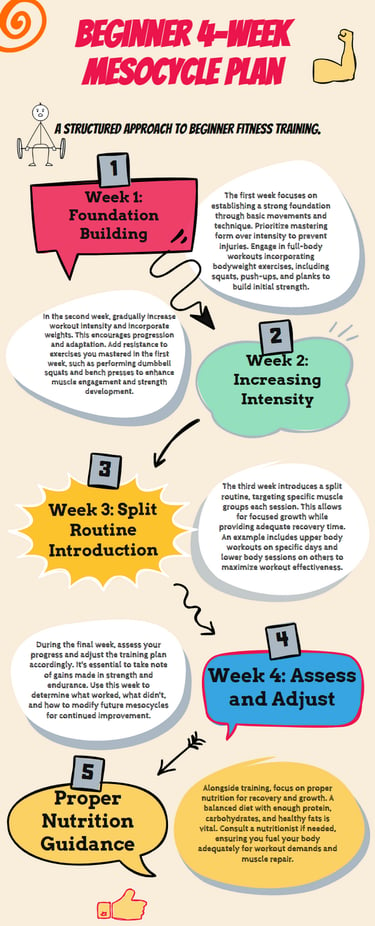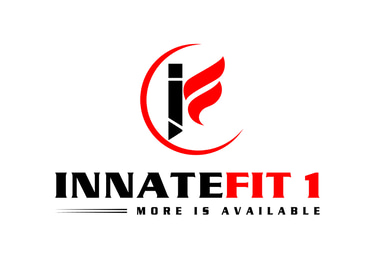Visit Innatefit1.com for exercise wear and equipment!!!
Mastering the Mesocycle: How Beginners Can Structure Their Training for Steady Strength Gains
Discover how to structure mesocycles for beginners and build strength the smart way. Learn simple, science-backed strategies for planning your training cycles, balancing recovery, and achieving consistent progress without burning out.
SELF-HELPWORKOUTSCONFIDENCE BUILDINGFITNESS TIPSSTRENGTH TRAININGHEALTH
Joseph Battle
10/5/20253 min read


Introduction
When you’re just starting your strength journey, progress feels magical. You pick up a dumbbell, follow a few YouTube workouts, and the gains roll in fast. But after a few weeks—or months—that progress starts to slow. Suddenly, your lifts plateau, your motivation dips, and your body feels stuck in neutral.
The truth is simple: you’ve outgrown random training. To keep moving forward, you need structure. That’s where mesocycles come into play—the heart of intelligent strength programming.
In this article, you’ll learn exactly how to structure mesocycles for beginners, why they matter, and how they can transform your progress from unpredictable to powerful.
Understanding the Mesocycle: The Building Block of Strength Progression
A mesocycle is a training phase lasting 3–6 weeks, designed around a specific goal, such as building strength, improving endurance, or enhancing hypertrophy (muscle size).
Think of it as a “chapter” in your training story. Each mesocycle connects to others, forming a larger narrative that moves you closer to your fitness goals.
For beginners, this structure is a game-changer. It transforms scattered workouts into a purpose-driven plan, ensuring every rep has meaning and direction.
Here’s the big picture:
Macrocycle: The full training year or overall goal (e.g., “get stronger over 12 months”).
Mesocycle: A focused block (3–6 weeks) working toward a smaller milestone.
Microcycle: The weekly layout of training sessions and recovery days.
Understanding this hierarchy enables you to build strength systematically, rather than randomly hoping for results.
Why Beginners Need Mesocycles More Than They Realize
Many beginners believe training variety is the key—changing exercises every week, switching programs, or chasing novelty. But constant change kills progress.
A mesocycle teaches consistency and focus. During those few weeks, your body adapts to progressive overload—a principle that forces muscles to grow stronger by gradually increasing stress over time.
When structured correctly, a mesocycle helps you:
Avoid Plateaus: Gradual progression keeps your muscles adapting instead of stagnating.
Prevent Burnout: Planned deloads and recovery phases protect your joints and nervous system.
Enhance Motivation: Visible progress within a few weeks keeps you mentally invested.
Build Foundation: Each mesocycle reinforces skills and movement patterns that carry over into future training phases.
For a beginner, it’s like learning the rhythm of strength—train, recover, repeat—with purpose and precision.
How to Structure a Beginner Mesocycle (Step-by-Step)
Let’s break down a simple beginner-friendly mesocycle structure that can be applied to nearly any goal.
1. Define Your Primary Goal (3–6 Weeks)
Choose one focus: strength, muscle growth, endurance, or fat loss.
For beginners, start by mastering strength and technique.
Example:
“Over the next 4 weeks, I’ll improve my squat and deadlift form while increasing my total volume by 10%.”
2. Determine Training Frequency
Beginners should train 3–4 days per week.
This allows for adequate recovery and neural adaptation—your brain and muscles learning to communicate efficiently.
Sample layout:
Day 1: Upper Body Strength
Day 2: Lower Body Strength
Day 3: Rest or Active Recovery
Day 4: Full Body or Accessory Work
3. Apply Progressive Overload
Each week, aim to increase one training variable:
Load: Add 2.5–5 lbs. to major lifts.
Volume: Add an extra set or rep.
Density: Decrease rest time slightly.
The goal isn’t to destroy your muscles—it’s to nudge your limits gradually.
4. Include a Deload Week
After 3–5 weeks, reduce volume or intensity by 30–50% for one week.
This “active rest” allows your body to recover, rebuild, and prepare for the next phase.
Skipping deloads is one of the biggest mistakes beginners make. Without them, fatigue compounds, performance dips, and motivation evaporate.
5. Reflect and Reset
At the end of the mesocycle, assess:
Did your lifts improve?
How’s your energy and recovery?
Are you ready to progress or repeat?
Use your results to build the next mesocycle—slightly harder, smarter, and more specific.
Common Mistakes to Avoid
Skipping Rest Days: Growth happens during recovery, not while lifting.
Program Hopping: Stick to your mesocycle before changing plans.
Ignoring Nutrition: Without fuel, your body can’t rebuild stronger tissue.
Not Tracking Progress: Logging your workouts makes invisible progress visible.
Going Too Heavy Too Soon: Strength takes time—chase consistency, not ego.
Conclusion: Small Phases, Big Results
A beginner mesocycle isn’t just a training plan—it’s a mindset shift. It teaches patience, discipline, and strategy. Each phase builds upon the last, creating momentum that propels you to grow both physically and mentally.
If you’re tired of spinning your wheels, stop guessing and start planning. Structure your training like a pro—one mesocycle at a time—and watch your strength, confidence, and results rise together.
Remember: the secret to long-term progress isn’t doing more—it’s doing better, on purpose.




